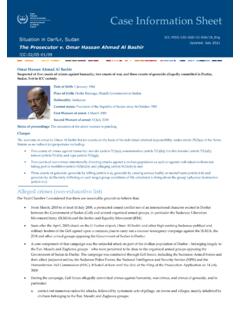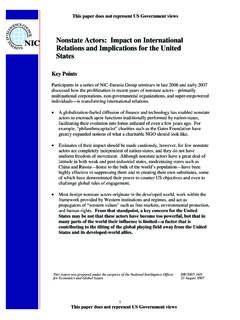Transcription of VOCABULARY OF THE HOLOCAUST - The Breman Museum
1 VOCABULARY OF THE HOLOCAUST Antisemitism - Prejudice towards, or discrimination against, Jews. Antisemitism was not new to Nazi Germany or Europe; feelings of hatred and distrust of Jews had existed there for centuries. ( Antisemitism can also be written with a hyphen, as anti-semitism, but the growing consensus is to write it without a hyphen.) Aryan - Aryan was used originally to identify peoples speaking the languages of Europe and India. The Nazis changed it to mean superior race, described as white, tall, athletic, with blond hair and blue eyes. Auschwitz - Usually refers to Auschwitz-Birkenau, the largest Nazi concentration camp, located 37 miles west of Cracow, Poland. Established in 1940, it became a huge camp complex that included a killing center and slave labor camps. Bar Mitzvah - Jewish religious ceremony held on a boy s thirteenth birthday marking his passage into manhood.
2 Bystander - One who is present at an event or who knows about its occurrence and chooses to ignore it. That is, he or she neither participates in, nor responds to it. Collaborator - In the context of war, one who cooperates with the enemy who is occupying his/her country and/or persecuting his/her people. Concentration camps - Nazi system for imprisoning those consider enemies of the state. Many different groups and individuals were imprisoned in concentration camps: religious opponents, resisters, homosexuals, Jehovah s Witnesses, Roma and Sinti (Gypsies), Poles, and Jews. Concentration camps were further subdivided into labor camps and death camps. Before the end of World War II, several thousand of these concentration camps were operating throughout Europe, in all countries conquered by the German army, especially Poland, Austria and Germany.
3 Crematoria - Furnaces constructed to burn human remains in the killing centers and concentration camps. The Germans had accepted bids for the construction of crematoria; many were built by German companies. Death Camps - (Also called extermination camps. ) These were concentration camps created for the sole purpose of killing people. Victims were murdered in assembly-line fashion oftentimes in gas chambers, and their bodies burned in open fields or crematoria, or buried in mass graves. The Nazis operated six death camps: Sobibor, Belzec, Treblinka, Chelmno, Auschwitz and Majdanek. Many concentration camps, such as Bergen-Belsen, Mathausen and Dachau, were also considered death camps because thousands were killed there by starvation, mistreatment, and disease. Death March - A forced march of Nazi prisoners from the camps toward the German interior at the end of World War II when the German armed forces were trapped between the Soviets to the east and the advancing Allied troops from the west.
4 Treated with enormous brutality during the forced marches, thousands of prisoners died either by starvation or exhaustion, or were shot to death. Dehumanization - Intended to change the manner in which a person or group of people are perceived. Dehumanization reduces the target group to objects therefore no longer human and worthy of human 2 rights or dignity. This was done by identifying people by numbers in place of their names, or as animals like pigs, or insects like cockroaches. Deportation - The act of being forced to leave where one is living. The Nazis coerced, tricked, and forced prisoners to leave their homes or ghettos, and board cattle cars destined for concentration camps and/or death camps. Prisoners in the overcrowded, unsanitary, cattle cars were given no food or water during the 2-4 day ride to the camps and many died.
5 Discrimination - An action that stems from prejudicial thinking that denies justice and fair treatment in employment, education, housing, or legal and civil rights. Displaced Persons Camps (DP Camps) - Camps set us after World War II as temporary living quarters for the thousands of homeless people created by the HOLOCAUST . Because in almost all cases their homes had been looted, stolen and/or destroyed, HOLOCAUST survivors no longer had homes to which to return. They lived in DP camps and then emigrated to new lives in the United States, Canada, Israel, Europe, South America, or Australia. Einsatzgruppen - German name for the SS mobile killing squads that followed the German army into Russia and eastern Poland. They rounded up Jews and other inferior people in the conquered territories, forced their victims to dig their own graves, into which they were shot.
6 At least one million Jews were killed by the Einsatzgruppen. Euphemism - A euphemism is a nice way of saying something terrible or something you wish to hide. The Nazis used euphemisms to use their true intentions from victims and bystanders such as: Final Solution, meaning the complete annihilation of all the Jews of Europe; Resettlement in the East, meaning deportation to concentration camps; Processing, meaning the selection, gassing, burning and disposal of people. Evian Conference - A conference convened by President Franklin D. Roosevelt in July 1938 to discuss the problem of refugees. The thirty-two countries who met in Evian-les-Bains, France did not accomplish much since most western countries were reluctant to accept Jewish refugees. Hitler interpreted this to mean that no one cared about the Jews and he could dispose of them as he wished.
7 Final Solution - Euphemism adopted at Wansee Conference (January 1942), refers to the final solution to the Jewish question in Europe. This was the Nazi code for the murder of all European Jews. Fuehrer - German word for leader. In Nazi Germany, Adolf Hitler was the supreme leader and was called the Fuhrer. Genocide The deliberate, systematic annihilation of a racial, religious, cultural, or political group of people. In genocide people are persecuted and murdered because of membership in the targeted victim group. In addition to the HOLOCAUST , genocide against targeted groups has also occurred in Cambodia (Asia), Bosnia (Eastern Europe), Rwanda (Africa), and now in darfur (in Sudan, Africa). Gentile Someone who is not of the Jewish faith, most often referring to a Christian. Gestapo The Nazi Secret State Police, Geheime Staatspolizei, who had absolute power and could arrest without a warrant.
8 Ghetto The Nazis revived the medieval 16th-century term ghetto to describe compulsory Jewish quarters in the poorest sections of the cities and towns they had conquered. Ghettos were closed off by walls, or fences made of wood and barbed wire. Entire families were imprisoned in ghettos, including young children and the elderly. Ghettos were extremely crowded and unsanitary. Lack of food, clothing, medicine, and other supplies, severe winter weather, and the absence of adequate municipal services led to repeated outbreaks of epidemics and to very high mortality rates. With the implementation of the Final Solution in late 1941, most ghettos were systematically destroyed. Residents were either shot in mass 3 graves located nearby or deported, usually by train, to death camps. The largest ghetto in Poland was the Warsaw Ghetto (pop.)
9 450,000); other major ghettos were established in the cities of Lodz, Krakow, Bialystok, Lvov, Lublin, Vilna, Kovno, Czestochowa, and Minsk. Gypsies Popular term for Roma and Sinti, nomadic people believed to have come originally from northwest India. Traveling in small caravans, Gypsies first appeared in Western Europe in the 1400s and eventually spread to every country of Europe. Approximately 250,000 to 500,000 Gypsies are believed to have died in Nazi camps, or killed by Einzatsgruppen and other shootings. HOLOCAUST With a small h, HOLOCAUST comes form the Greek olokauston, and means an offering consumed by fire. With a capital H it means the destruction of the Jewish people of Europe by the Nazis during the period from 1933 to 1945. Jehovah s Witnesses A religious sect that originated in the United States and had about 20,000 members in Germany in 1933.
10 The religious beliefs of Jehovah s Witnesses did not allow them to swear allegiance to any worldly power. They were, therefore, persecuted by the Nazis as enemies of the state. About 10,000 Witnesses were imprisoned in concentration camps; about 2,500 of them died. Jewish Council In German, Judenrat. Councils of Jewish leaders were established by the Nazis in the ghettos of German-occupied towns and cities to impose Nazi decrees on the Jews. The Nazis used Jewish Councils as buffers between themselves and the Jewish populations of the ghettos. Kindertransport German for children's transport. Between 1938 and 1940 the informal name of a rescue effort which brought thousands of refugee Jewish children to Great Britain from Nazi Germany. About 1,000 children were rescued and also brought to the United States, including a few to Georgia.







